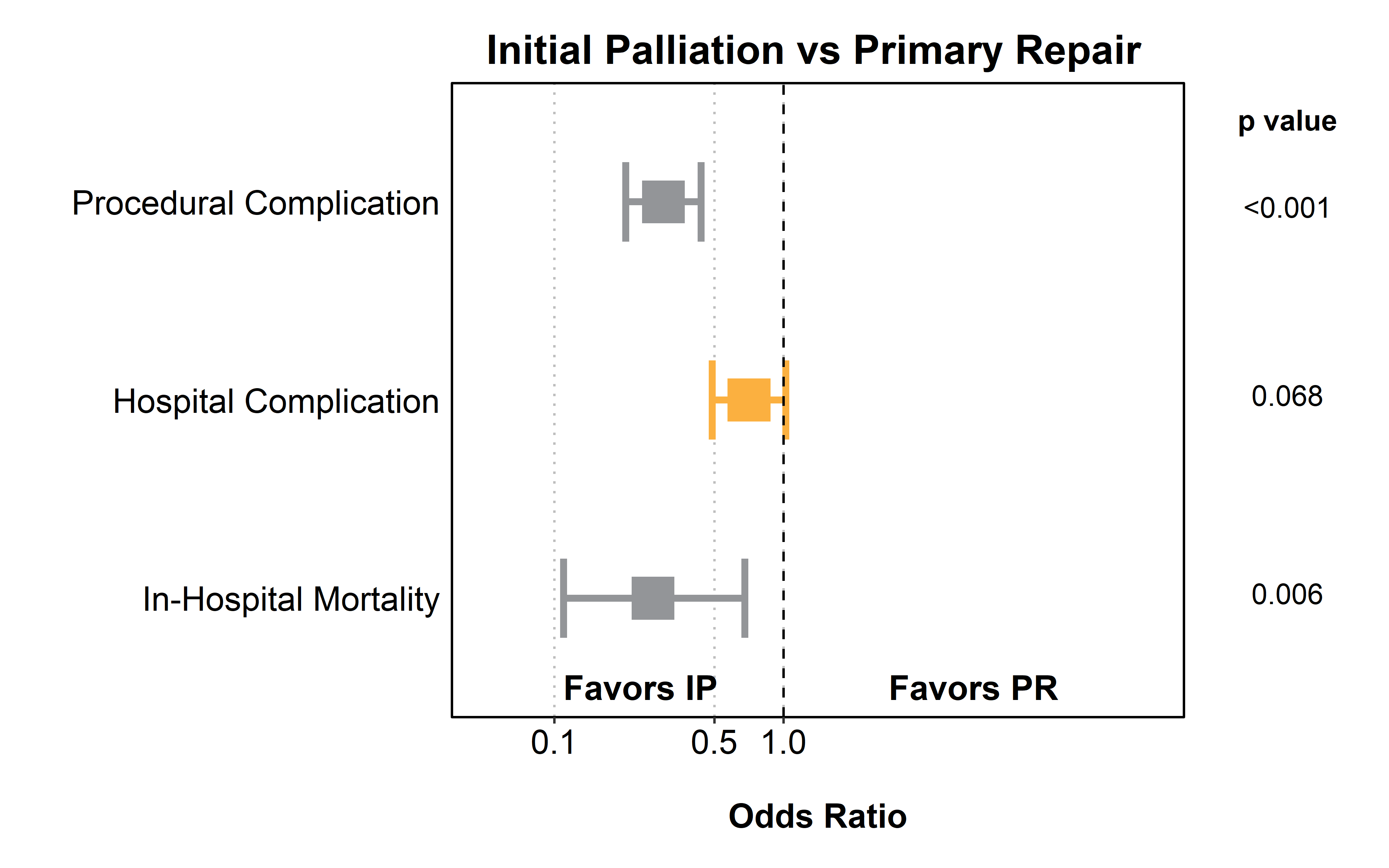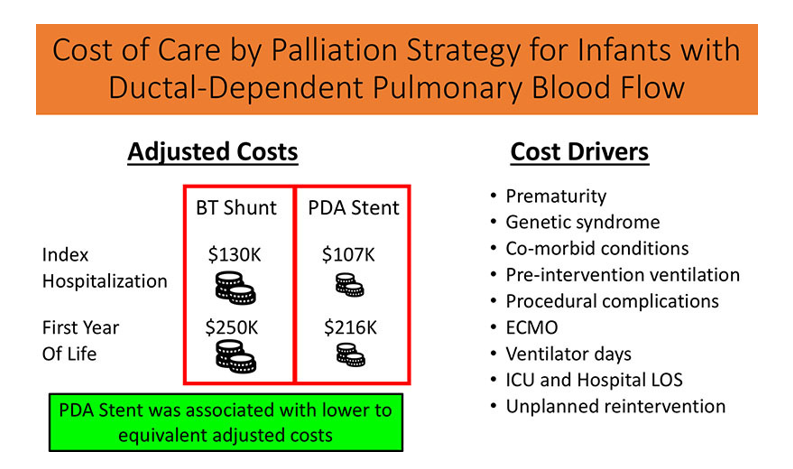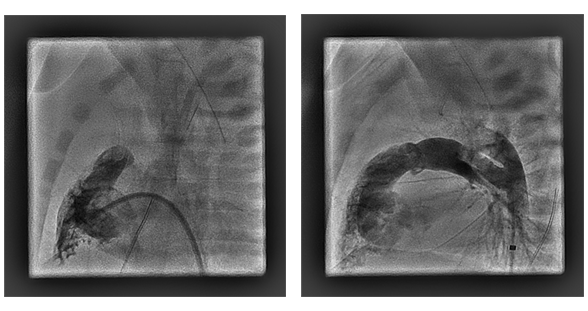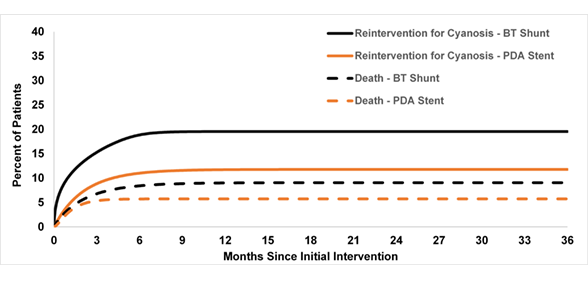Our Studies
Ongoing Studies
Comparison of Management Strategies for the Neonate with Symptomatic Tetralogy of Fallot

Neonates with tetralogy of Fallot and symptomatic cyanosis (sTOF) require early intervention. Management strategies include initial palliation (IP) followed by later complete repair (CR) or primary repair (PR). This study aimed to thoroughly compare outcomes between these treatment strategies using propensity score adjustment (PSA) to account for baseline differences between groups. Early mortality, risk exposure and procedural complications were lower in the IP group, but cumulative exposures and reinterventions favored the PR group, suggesting each strategy has potential benefits.
Completed Studies
Differences in Cost of Care - PDA Stent and Modified BT Shunt

In infants with ductal-dependent pulmonary blood flow (PBF), initial palliation with patent ductus arteriosus stent (DAS) or modified Blalock-Taussig shunt (BTS) have comparable mortality but discrepant hospital length of stay (LOS) and procedural complication rates, which may influence cost. With limited economic impact information of these palliation strategies, this multi-center study compared costs of both palliations discovering advantages for DAS patients over the first year of life due largely to lower room and lab costs.
Aortic Valve Morphology & Outcomes

Congenital aortic valve stenosis is relative common congenital heart lesion, that frequently necessitates transcatheter intervention. The natural history of this lesion has been well defined, as has long-term outcomes following transcatheter balloon aortic valvuloplasty. Less well defined, however, is the relationship between underlying valvular morphology and clinical outcomes. This multi-center retrospective study sought to address this query, and demonstrated that aortic valves with lesser commissural fusion and larger openings have higher rates of leaflet tears, which in turn are associated with the development of aortic insufficiency.
PA/IVS Outcomes After RV Decompression

Outcomes following right ventricular (RV) decompression in infants with pulmonary atresia and intact ventricular septum (PA-IVS) vary widely. Descriptions of these outcomes have previously been limited to small single-center studies. In this retrospective study using a large, multi-center, and modern dataset - by far the largest assembled to date - we demonstrated that the severity of pre-intervention tricuspid valve regurgitation, even more so than tricuspid valve annular dimension, was closely related to key clinical outcomes including risk of reintervention and ultimate circulatory status. Current work focuses on technical aspects of the procedure and medium-term echocardiographic follow-up of RV growth parameters.
BT Shunt vs. PDA Stent for Neonates with Ductal Dependent Pulmonary Blood Flow

Newborns with cyanotic congenital heart disease and ductal dependent pulmonary blood flow (PBF) require a durable source of PBF until a more definitive repair or subsequent palliation can be performed. Treatment options include surgically placed systemic to pulmonary artery shunts (typically a Blalock-Taussig or BT shunt) or transcatheter patent ductus arteriosus stent placement (PDA stent). These approaches may be associated with distinct risks and outcomes. This retrospective study sought to compare adjusted procedural and medium-term outcomes following BT shunt or PDA stent placement in a large multi-center dataset, far eclipsing the size of existing datasets addressing this population. We demonstrated that mortality and the risk of unplanned reintervention to treat cyanosis were similar between cohorts, while morbidity, length of stay, and pulmonary artery size and symmetry at the time of repair/palliation all favored the PDA stent group. Current work focuses on the relative economic impact of these distinct strategies, and on evaluation of both somatic and pulmonary arterial growth during the interstage.
Publications Peer-Reviewed
Relation of Aortic Valve Morphologic Characteristics to Aortic Valve Insufficiency and Residual Stenosis in Children with Congenital Aortic Stenosis Undergoing Balloon Valvuloplasty.
Am J Cardiol. 2016 Mar 15;117(6):972-9. Epub 2015 Dec 31. PMID: 26805657.
View Online Publication
Aortic Valve Morphology Affects Left Ventricular Systolic Function in Children with Congenital Aortic Stenosis.
J Invasive Cardiol. 2016 Sep;28(9):381-8. PMID: 27591689.
View Online Publication
Outcomes and Risk Factors for Re-Intervention in Children Undergoing Right Ventricle Decompression for Pulmonary Atresia Intact Ventricular Septum: Results from a Multi-Center Collaborative.
Circ Cardiovasc Interv. 2017 May;10(5). PMID: 28500137.
View Online Publication
A Comparison Between Patent Ductus Arteriosus Stent and Modified Blalock-Taussig Shunt as Palliation for Infants with Ductal-Dependent Pulmonary Blood Flow: Insights from the Congenital Catheterization Research Collaborative.
Circulation. 2018 Feb 6;137(6):589-601. PMID: 29042354.
View Online Publication
Technical Factors Are Associated with Complications and Repeat Intervention in Neonates Undergoing Transcatheter Right Ventricular Decompression for Pulmonary Atresia and Intact Ventricular Septum: Results from the Congenital Catheterization Research Collaborative.
Cardiol Young. 2018 Aug;28(8):1042-1049. PMID: 29909817
View Online Publication
Echocardiographic Parameters Associated with Clinical Outcome and Right Ventricular Growth Following Right Ventricular Decompression in Patients with Pulmonary Atresia Intact Ventricular Septum: Results from a Multicenter Study.
Congenit Heart Dis. 2018 Sep 21. PMID: 30238627.
View Online Publication
Classification scheme for ductal morphology in cyanotic patients with ductal dependent pulmonary blood flow and association with outcomes of patent ductus arteriosus stenting.
Catheter Cardiovasc Interv. 2019 Apr 1;93(5):933-943. PMID: 30790426.
View Online Publication
Comprehensive Comparative Outcomes in Children with Congenital Heart Disease: The Rationale for the Congenital Catheterization Research Collaborative.
Congenit Heart Dis. 2019 May;14(3):341-349. PMID: 31183955.
View Online Publication
Differences in Cost of Care by Palliation Strategy for Infants with Ductal-Dependent Pulmonary Blood Flow: Results from a Multicenter Study of Patent Ductus Arteriosus Stent and Modified Blalock-Taussig Shunt.
Circ Cardiovasc Interv. 2019 Apr;12(4):e007232. PMID: 30998390.
View Online Publication
Comparison of Outcomes at Time of Superior Cavopulmonary Connection Between Single Ventricle Patients With Ductal-Dependent Pulmonary Blood Flow Initially Palliated With Either Blalock-Taussig Shunt or Ductus Arteriosus Stent: Results From the Congenital Catheterization Research Collaborative.
Circ Cardiovasc Interv. 2019 Oct;12(10):e008110. PMID: 31607156.
View Online Publication
Use of Carotid and Axillary Artery Approach For Stenting the Patent Ductus Arteriosus In Infants with Ductal-Dependent Pulmonary Blood Flow: A Multicenter Study from the Congenital Catheterization Research Collaborative.
Catheter Cardiovasc Interv. 2020 Mar 1;95(4):726-733. PMID: 31815357.
View Online Publication
Impact of Palliation Strategy on Interstage Feeding and Somatic Growth for Infants With Ductal-Dependent Pulmonary Blood Flow: Results from the Congenital Catheterization Research Collaborative.
J Am Heart Assoc. 2020 Jan 7;9(1):e013807. PMID: 31852418.
View Online Publication
Use of Novel "Flip Technique" Aids in Percutaneous Carotid Artery Approach in Neonates
JACC Cardiovasc Interv. 2019 Aug 26;12(16):1630-1631. PMID: 31439347.
View Online Publication
Echocardiographic versus Angiographic Measurement of the Aortic Valve Annulus in Children Undergoing Balloon Aortic Valvuloplasty: Method Affects Outcomes.
Cardiol Young. 2020 Dec;30(12):1923-1929. PMID: 33050969.
View Online Publication
Impact of Treatment Strategy on Outcomes in Isolated Pulmonary Artery of Ductal Origin: A Multicenter Report from the Congenital Catheterization Research Collaborative.
Pediatr Cardiol. 2021 Mar;42(3):533-542. PMID: 33394118.
View Online Publication
Comparison of Management Strategies for the Neonate with Symptomatic Tetralogy of Fallot.
J Am Coll Cardiol. 2021 Mar 2;77(8):1093-1106. PMID: 33632484.
View Online Publication
Comparison of Management Strategies for the Neonate with Symptomatic Tetralogy of Fallot and Weight Less than 2.5 kg.
J Thorac Cardiovasc Surg. 2022 Jan;163(1):192-207.e3. PMID: 33726912.
View Online Publication
Data Quality Methods Through Remote Source Data Verification Auditing: Results from the Congenital Cardiac Research Collaborative.
Cardiol Young. 2021 Nov;31(11):1829-1834. PMID: 33726868.
View Online Publication
Comparison of Patent Ductus Arteriosus Stent and Blalock-Taussig Shunt as Palliation for Neonates with Sole Source Ductal-Dependent Pulmonary Blood Flow: Results from the Congenital Catheterization Research Collaborative.
Peds Cardiol. 2022 Jan;43(1):121-131. PMID: 34524483.
View Online Publication
Factors Influencing Reintervention Following PDA Stent Implantation for Ductal Dependent Pulmonary Blood Flow: Results from the Congenital Catheterization Research Collaborative.
Circ Cardiovasc Interv. 2021 Dec;14(12):e010086. PMID: 34789017.
View Online Publication
Comparative Costs of Management Strategies for Neonates with Symptomatic Tetralogy of Fallot: A study combining data from the Congenital Cardiac Research Collaborative and The Pediatric Health Information Systems Database.
J Am Coll Cardiol. 2022 Mar 29;79(12):1170–1180. PMID: 35331412.
View Online Publication
Palliation Strategy to Achieve Complete Repair in Symptomatic Neonates with Tetralogy of Fallot.
Pediatr Cardiol. 2022 Apr 5. PMID: 35381860.
View Online Publication
Impact of Management Strategy on Feeding and Somatic Growth in Neonates with Symptomatic Tetralogy of Fallot: Results from the Congenital Cardiac Research Collaborative.
J Pediatr. 2022 Jun 27:S0022-3476(22)00598-4. PMID: 35772511.
View Online Publication
Comparison of Treatment Strategies for Neonates with Tetralogy of Fallot and Pulmonary Atresia.
J Thorac Cardiovasc Surg. 2023 Jan 14. PMID: 36828672.
View Online Publication
Pulmonary Artery Hypoplasia in Neonates with Tetralogy of Fallot.
J Am Coll Cardiol. 2023 Aug 15;82(7):615-627. PMID: 37558375.
View Online Publication
Outcomes Following Balloon Pulmonary Valvuloplasty in Symptomatic Neonates with Tetralogy of Fallot – CCRC Study.
J Soc Cardiovasc Angio Interv. 2023.
Grants & Awards
Andrew C Glatz
November 2016
Athar M Qureshi
January 2017
Bryan H Goldstein
November 2019
Jeffrey D Zampi and George T Nicholson
September 2020


